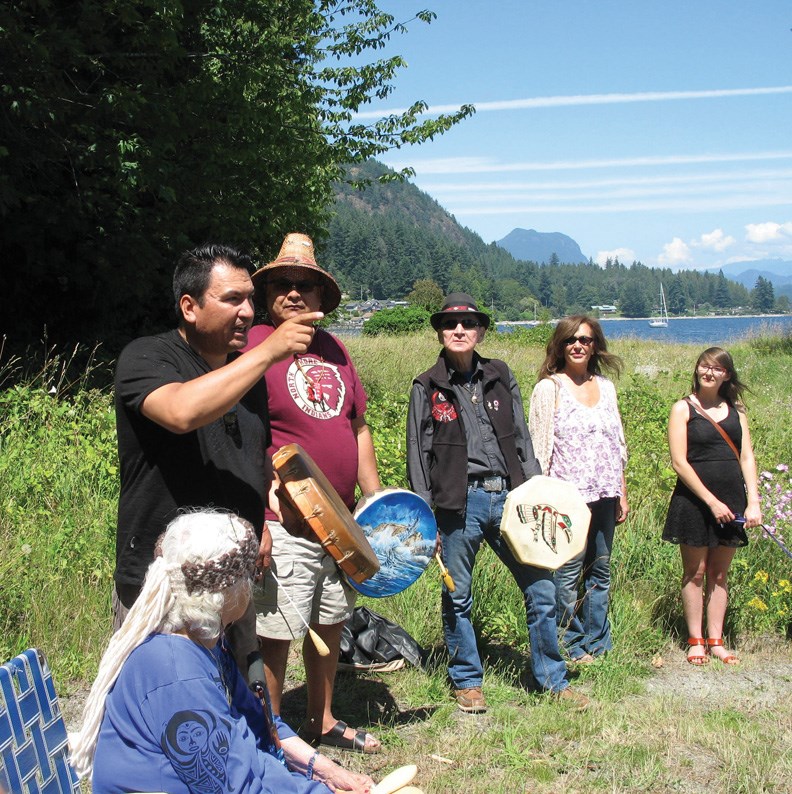Squamish Nation leaders, including the chief, an elder, councillors and artists, led a walk to ancestral Squamish (Skwxwú7mesh) land near Gibsons on June 29, and they invited the public to walk with them. The occasion was a celebration of art and culture for the indigenous peoples on show at the Gibsons Public Art Gallery (GPAG).
Artwork arrived at the gallery the day before with the organizing assistance of Squamish councillors Danielle Mellish, Dennis Joseph and Byron Joseph, and by noon Wednesday the paintings, carvings, jewelry, weaving and several heritage pieces from the Squamish collection were on display.
Gallery president Stewart Stinson and Gibsons Mayor Wayne Rowe welcomed the band members. Chief Ian Campbell (Xalek’ Sekyn Siyam) had a piece in the show, a painted wall panel titled High Alpine Specialist. He introduced an elder, Audrey Rivers, who told the crowd that the legacies of her people were sacred to all the artists. The chief explained that their first ancestor story came from this area – from the waterfront land called Chekwelp, along Marine Drive, and he urged the non-indigenous to pronounce it in the correct way, more like Chek-wah.
The chief and councillors led the drumming and dancing along with some of the artists including Robert Yelton, Stanley Park’s totem pole carver, who did not have work in the show but brought his drum and lively personality.
The gallery set out cheese and fruit plates for lunch, then a late arriving contingent of Squamish members brought a feast of salmon and bannock and invited everyone to share while viewing the art.
Artist Art Harry wore traditional vest, a headband with beadwork and an eagle feather as he explained the symbolism of the image on his circular cedar box.
“The eagle carries our prayers and thoughts to the Creator,” he said.
Many traditional images were used in other artwork without necessarily using traditional colours. Artist Anthony Joseph’s acrylics on canvas depicted the bear, the eagle and the moon in soft green and reddish brown.
The craftsmanship of Jody Broomfield is outstanding. His carved cedar salmon panel in a light green has a contemporary look.
“The green reminds me of tarnishing of copper,” he said. “Copper was a sign of wealth for our people.” He also works in various mediums and shows an aluminum cut-out that represents the body of a salmon mounted on a granite stand. Broomfield’s larger sculptures can be seen at Park Royal Centre in West Vancouver.
Another dramatic piece was Lyle Williams Jr.’s Sun Mask along with his smaller Bear Mask. The weaving along one wall of the gallery is by Alison Burns and Danielle Morsette. One of the most interesting pieces is a cedar, fur-trimmed shawl by Deanna Lewis that has been polished with bear grease. Jana Benson is one of the few Squamish artists living in Gibsons and she is showing her banners painted for the town’s 2014-15 banner project.
That same afternoon, band members were joined on their walk to Chekwelp by about 20 non-indigenous people curious to learn more. After walking to Armours Beach and along the shore to the grassy area that once held the village, the group formed a circle and heard from an elder, several councillors and the chief who told the legend of how the Squamish people came to be on that site.
The art show at GPAG runs until July 24. The gallery hosted its first exhibition of Squamish Nation art in 2007 to great success and has been keen to feature a new showcase of art and culture ever since.



